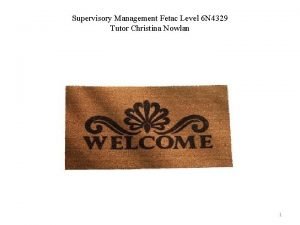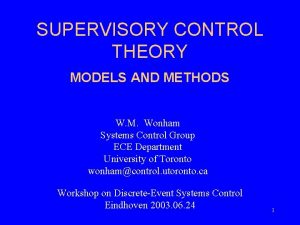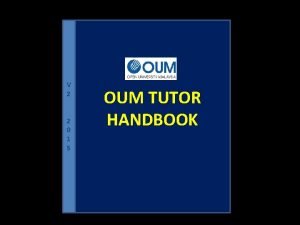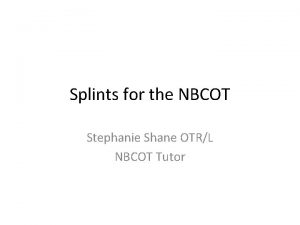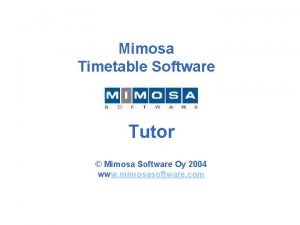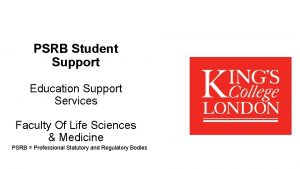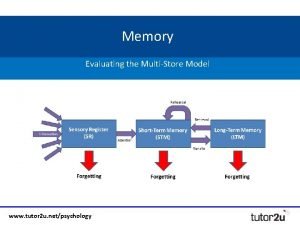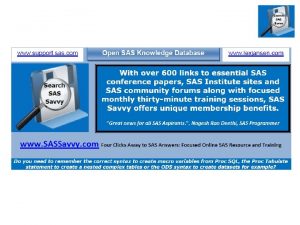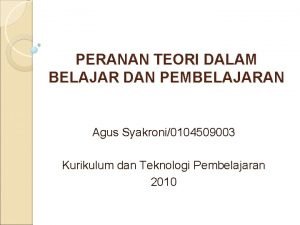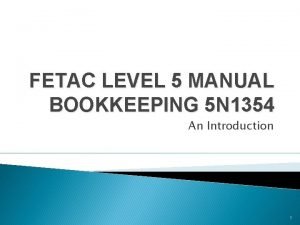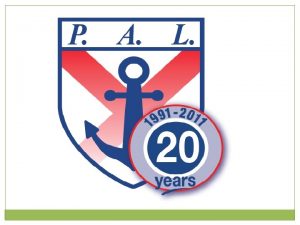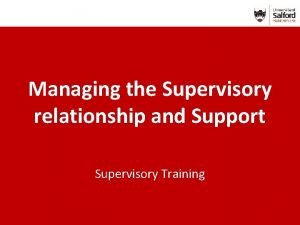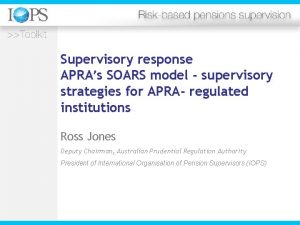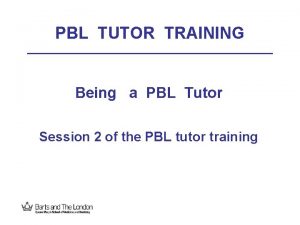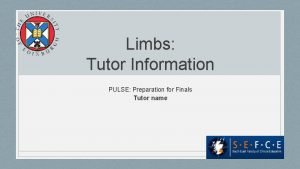Supervisory Management Fetac Level 6 N 4329 Tutor
































































- Slides: 64

Supervisory Management Fetac Level 6 N 4329 Tutor Christina Nowlan 1

Supervisory Management Fetac Level 6 N 4329 Tutor Christina Nowlan Ø Supervisory Management 6 N 4329 Ø Credits – 15 Credits Ø Duration- 150 hours over 10 weeks. Monday & Wednesday 6. 30 pm-9. 30 pm ØCourse Structure – 60 Hours Direct Tuition 90 Hours Practice, Study/Reflective activities, Preparation Ø Attendance – 80% Attendance required 2

Supervisory Management Fetac Level 6 N 4329 Tutor Christina Nowlan Assessment Type Duration Weighting Stage of Assessment Portfolio Four Weeks 40% On Completion of Units 1 & 2 Skills Demonstration 1 Two Weeks 30% On Completion of Units 3 & 4 Skills Demonstration 2 (One Hour) Three weeks 30% On Completion of Units 5 & 6 3

Supervisory Management Fetac Level 6 N 4329 Tutor Christina Nowlan Beware of Plagiarism! v. We must give credit to the source when using other people’s ideas. v. Harvard style referencing

Supervisory Management Fetac Level 6 N 4329 Tutor Christina Nowlan Assessment Cont. Skills Demonstration A skills demonstration is used to assess a wide range of practical based learning outcomes including practical skills and knowledge. A skills demonstration will require the learner to complete a task or series of tasks that demonstrate a range of skills. Portfolio / Collection of Work A portfolio or collection of work is a collection and/or selection of pieces of work produced by the learner over a period of time that demonstrates achievement of a range of learning outcomes. The collection may be self-generated or may be generated in response to a particular brief or tasks/activities devised by the assessor. 5

Supervisory Management Fetac Level 6 N 4329 Tutor Christina Nowlan Module Outline The module is made up of six sections; 1. Introduction to supervisory management 2. Organisational planning 3. Recruitment 4. Training 5. Performance Management 6. Record Keeping and Data protection. Having studied these the learning objectives listed below should be achieved by the learner. 6

Supervisory Management Fetac Level 6 N 4329 Tutor Christina Nowlan Learning Objectives Having completed the module Learners should be able to: 1. Summarise the duties and responsibilities of a supervisory manager, to include reference to relevant policies and services in the chosen vocational or work environment 2. Evaluate up to date industry standards, guidelines and recommended practices that affect the work environment, to include the purpose and methods of supervision, the staff code of conduct, advantages and disadvantages of in house and contract staff, and of membership of professional or trade associations, trade unions and/or a works committees. 3. Describe the precautions necessary to safeguard information and/or records. 4. Describe key steps required to recruit staff, to include pre planning, methods to source and screen staff, use of an application form to shortlist candidates, and the benefits of a chosen approach 7

Supervisory Management Fetac Level 6 N 4329 Tutor Christina Nowlan Learning Objectives Cont. Ø Analyse the risks for which adequate insurance cover is recommended Ø Draft a range of procedures for work related activities, to include lines of communication with clients, colleagues and other relevant parties, procedures for maintaining effective standards of service, criteria for staff recruitment, criteria for supervisory procedures. Ø Devise a system for maintaining work related records, to include operational records, a work roster for operational staff, and a maintenance schedule for equipment and vehicles Ø Prepare a departmental budget, to include details of planned spending under a number of headings and of contingency spending 8

Supervisory Management Fetac Level 6 N 4329 Tutor Christina Nowlan Learning Objectives Cont. Ø Train staff, drawing on up to date industry standards in training using appropriate aids and supporting material, and assessing the suitability of individuals during the training session Ø Carry out staff evaluations to include achievement of objectives, feedback on performance, and identification of opportunities for personal development. 9

Supervisory Management Fetac Level 6 N 4329 Tutor Christina Nowlan Course Materials/Books • There are no Specific text books for this module, notes can be downloaded or saved to your own desktop for study. https: //supervisorymanagement. wordpress. com/ If for some reason you do not have access to the internet then please let me know. • These notes provide additional and supporting information for topics covered in class. • Throughout the notes Reflective activities (In Blue text boxes) are included, these are designed to help you apply course theory in a practical way. Please complete these and keep them in a folder for inspection. 10

Supervisory Management Fetac Level 6 N 4329 Tutor Christina Nowlan What you need to bring: • Pens, Pencils, Colours etc. • A 4 writing pad • A 4 Folder for keeping notes handouts etc. • Any other materials you wish to bring. 11

Supervisory Management Fetac Level 6 N 4329 Tutor Christina Nowlan To help our programme run smoothly please: Ø Treat all learners and staff with respect and dignity. Ø Be on time for classes, if you are late do not enter until after break, as this disturbs the class Ø Notify the tutor or the centre if you cannot attend a class for any reason. Ø Undertake all work assigned to you for the course Ø Take note of deadlines for assignments etc. 12

Supervisory Management Fetac Level 6 N 4329 Tutor Christina Nowlan In respect of your fellow students Please keep your phone off and in your bag for the duration of the class. If you need to have access to your phone then keep it on mute and please DO NOT ANSWER it in class, leave quietly and answer it outside the room. 13

Supervisory Management Fetac Level 6 N 4329 Tutor Christina Nowlan 14

Supervisory Management Fetac Level 6 N 4329 Tutor Christina Nowlan A Supervisor Is a first-level management employee who is usually responsible for a small group of employees. As a member of management, a supervisor's main job is more concerned with orchestrating and controlling work than with performing it directly 15

Supervisory Management Fetac Level 6 N 4329 Tutor Christina Nowlan Henry Fayol (1049) Five functions of management practice

Supervisory Management Fetac Level 6 N 4329 Tutor Christina Nowlan 17

Supervisory Management Fetac Level 6 N 4329 Tutor Christina Nowlan 18

Supervisory Management Fetac Level 6 N 4329 Tutor Christina Nowlan Organization Chart A chart that shows the structure of the organization including the title of each manager’s position and, by means of connecting lines, who is accountable to whom and who has authority for each area. G. Dessler, 2003 April 18, 2006 LIS 580 - Spring 2006 19

Supervisory Management Fetac Level 6 N 4329 Tutor Christina Nowlan 20

Supervisory Management Fetac Level 6 N 4329 Tutor Christina Nowlan What Determines Organization Structure þ þ þ Environment. Fast-changing environments require organic structures; slowly changing environments favor mechanistic structures. Technology. Unit and continuous production processes favor organic structures. Mass production processes favor mechanistic structures. Goals. Ask, “What are the main goals we want to achieve via this organization? ” Pros and cons. Each approach to departmentalization has pros and cons. Logic and common sense. G. Dessler, 2003 April 18, 2006 LIS 580 - Spring 2006 21

Supervisory Management Fetac Level 6 N 4329 Tutor Christina Nowlan Structure Variables Principles – – – Departmentalization – Functional – Divisional • Product • Customer • Geographic • Process Chain of command Span of control Authority Power Responsibility Prentice Hall, 2002 April 18, 2006 LIS 580 - Spring 2006 22

The Four Organizational Boundaries That Matter Source: Reprinted by permission of Harvard Business Review. “The Four Organizational Boundaries that Matter, ” from “The New Boundaries of the Boundaryless Company, ” by Larry Hirschorn and Thomas Gilmore, May–June 1992. Copyright © 1992 by the President and Fellows of Harvard College. All rights reserved. April 18, 2006 LIS 580 - Spring 2006 FIGURE 0– 3 G. Dessler, 2003 23

Types of organisation Tall organisations have many levels of hierarchy. The span of control is narrow and there are opportunities for promotion. Lines of communication are long, making the firm unresponsive to change. Flat organisations have few levels of hierarchy. Lines of communication are short, making the firm responsive to change. A wide span of control means that tasks must be delegated and managers can feel overstretched.


Supervisory Management Fetac Level 6 N 4329 Tutor Christina Nowlan Tall And Flat Organizations, And The Span Of Control • Span of Control – The number of subordinates reporting directly to a supervisor. • Wide spans: larger number of direct reports. • Narrow spans: fewer number of direct reports. • Tall vs. Flat Organizations – Tall organizations: more management layers and more hierarchical controls. – Flat organizations: fewer management layer and decision making closer to the customer. G. Dessler, 2003 April 18, 2006 LIS 580 - Spring 2006 26

Supervisory Management Fetac Level 6 N 4329 Tutor Christina Nowlan Centralised Vs Decentralised In centralised organisations, the majority of decisions are taken by senior managers and then passed down the organisational hierarchy. Decentralised organisations delegate authority down the chain of command, thus reducing the speed of decision making. One method of reducing costs is to remove a layer of management in a hierarchy while expecting staff to produce the same level of output. This is called delayering. 27

Supervisory Management Fetac Level 6 N 4329 Tutor Christina Nowlan Matrix Organization – An organization structure in which employees are permanently attached to one department but also simultaneously have ongoing assignments in which they report to project, customer, product, or geographic unit heads. G. Dessler, 2003 April 18, 2006 LIS 580 - Spring 2006 28

Supervisory Management Fetac Level 6 N 4329 Tutor Christina Nowlan 29

Supervisory Management Fetac Level 6 N 4329 Tutor Christina Nowlan Matrix Organizations Advantages • Access to expertise. • Stability of permanent department assignments for employees. • Allows for focus on specific projects, products, or customers. Disadvantages • Confusion of command. • Power struggles and conflicts. • Lost time in coordinating. • Excess overhead for managing matrix functions. G. Dessler, 2003 April 18, 2006 LIS 580 - Spring 2006 30

Supervisory Management Fetac Level 6 N 4329 Tutor Christina Nowlan 31

Supervisory Management Fetac Level 6 N 4329 Tutor Christina Nowlan Functional vs. Divisional Organizations þ Functional Organization Advantages 1. 2. 3. 4. It is simple, obvious, and logical. It fosters efficiency. It can simplify executive hiring and training. It can facilitate the top manager’s control. þ Functional Organization Disadvantages 1. It increases the workload on the executive to whom the functional department heads report. 2. It may reduce the firm’s sensitivity to and service to the customer. 3. It produces fewer general managers. G. Dessler, 2003 April 18, 2006 LIS 580 - Spring 2006 32

Supervisory Management Fetac Level 6 N 4329 Tutor Christina Nowlan Divisional Organization Advantages 1. 2. 3. 4. The product or service gets the single-minded attention of its own general manager and unit, and its customers may get better, more responsive service. It’s easier to judge performance. It develops general managers. It reduces the burden for the company’s CEO. G. Dessler, 2003 April 18, 2006 LIS 580 - Spring 2006 33

Supervisory Management Fetac Level 6 N 4329 Tutor Christina Nowlan Divisional Organization Disadvantages 1. 2. 3. 4. It creates duplication of effort. It may diminish top management’s control. It requires more managers with general management abilities. It can breed compartmentalization. G. Dessler, 2003 April 18, 2006 LIS 580 - Spring 2006 34

Supervisory Management Fetac Level 6 N 4329 Tutor Christina Nowlan 35

Supervisory Management Fetac Level 6 N 4329 Tutor Christina Nowlan Learning Outcomes Ø Develop a clear understanding of the various methods of supervision. Ø Identify the most appropriate form of supervision for the organisation. Ø Understand the advantages and disadvantages of membership of organisations/committees. 36

Supervisory Management Fetac Level 6 N 4329 Tutor Christina Nowlan Leadership/Supervisory Styles Supervisors often have to perform many roles in an organization and how they handle various situations will depend on their styles of management. A management style is an overall method of leadership used by a manager. Three main styles: – Autocratic – Democratic – Laissez-faire (Kurt Lewin 1939)

Supervisory Management Fetac Level 6 N 4329 Tutor Christina Nowlan Management Styles Autocratic – an autocratic or authoritarian manager makes all the decisions, keeping the information and decision making among the senior management. – the direction of the business will remain constant, and the decisions will be quick and similar, this in turn can project an image of a confident, well managed business. – However subordinates may become dependent upon the leaders and supervision may be needed; – This style can decrease motivation and increase staff turnover

Supervisory Management Fetac Level 6 N 4329 Tutor Christina Nowlan Why do you think that an Autocratic form of leadership may reduce motivation? When would this form of leadership be appropriate? 39

Supervisory Management Fetac Level 6 N 4329 Tutor Christina Nowlan Management Styles Democratic (participative) – The manager allows the employees to take part in decision-making: therefore everything is agreed by the majority. (empowerment) – This style can be particularly useful when complex decisions need to be made that require a range of specialist skills; – From the overall business' point of view, job satisfaction and quality of work will improve. – The decision-making process is severely slowed down, and the need of a consensus may avoid taking the 'best' decision for the business.

Supervisory Management Fetac Level 6 N 4329 Tutor Christina Nowlan Management Styles Laissez-faire (free-rein) – The leader delegates much authority to employees; the leader's role is peripheral and staff manage their own areas of the business. – The style brings out the best in highly professional and creative groups of employees. –The leader therefore evades the duties of management and uncoordinated delegation occurs; –This leads to a lack of staff focus and sense of direction, which in turn leads to much dissatisfaction, and a poor company image

Supervisory Management Fetac Level 6 N 4329 Tutor Christina Nowlan Supervisory/ Management Styles • Various management styles can be employed dependent on the culture of the business, the nature of the task, the experience and personalities of the workforce and the personality and skills of the leaders. • Managers should exercise a range of management styles and should deploy them as appropriate.

Supervisory Management Fetac Level 6 N 4329 Tutor Christina Nowlan Theories 43

Supervisory Management Fetac Level 6 N 4329 Tutor Christina Nowlan Trait theories: Is there a set of characteristics that determine a good leader? – – – Personality? Dominance and personal presence? Charisma? Self confidence? Achievement? Ability to formulate a clear vision? 44

Supervisory Management Fetac Level 6 N 4329 Tutor Christina Nowlan Behavioural: Implies that leaders can be trained – focus on the way of doing things – Structure based behavioural theories – focus on the leader instituting structures – task orientated – Relationship based behavioural theories – focus on the development and maintenance of relationships – process orientated 45

Supervisory Management Fetac Level 6 N 4329 Tutor Christina Nowlan Contingency Theories: • Leadership as being more flexible – different leadership styles used at different times depending on the circumstance. • Suggests leadership is not a fixed series of characteristics that can be transposed into different contexts 46

Supervisory Management Fetac Level 6 N 4329 Tutor Christina Nowlan 47

Supervisory Management Fetac Level 6 N 4329 Tutor Christina Nowlan Which Theory ‘Fits’ may depend on; Ø Ø Ø Type of staff History of the business Culture of the business Quality of the relationships Nature of the changes needed Accepted norms within the institution 48

Supervisory Management Fetac Level 6 N 4329 Tutor Christina Nowlan 49

Supervisory Management Fetac Level 6 N 4329 Tutor Christina Nowlan Membership of Organisations and Committees A professional organisation; Ø Represents and promotes a profession Ø They are usually non-profit and are funded by members contributions/fees. Ø Cover a wide variety of professions. 50

Supervisory Management Fetac Level 6 N 4329 Tutor Christina Nowlan Examples of Professional organisations Include; 1. The Marketing Institute of Ireland 2. Advertising Standards authority of Ireland 3. Enterprise Ireland 51

Supervisory Management Fetac Level 6 N 4329 Tutor Christina Nowlan Professional Organisation Structure Includes; 1. An elected executive board 2. A number of committees to represent special interest groups 3. A membership system 4. A resource facility e. g. a library 5. A communication method e. g. a monthly newsletter 52

Supervisory Management Fetac Level 6 N 4329 Tutor Christina Nowlan 53

Supervisory Management Fetac Level 6 N 4329 Tutor Christina Nowlan 54

Supervisory Management Fetac Level 6 N 4329 Tutor Christina Nowlan 55

Supervisory Management Fetac Level 6 N 4329 Tutor Christina Nowlan 56

Supervisory Management Fetac Level 6 N 4329 Tutor Christina Nowlan 57

Supervisory Management Fetac Level 6 N 4329 Tutor Christina Nowlan 58

Supervisory Management Fetac Level 6 N 4329 Tutor Christina Nowlan 59

Supervisory Management Fetac Level 6 N 4329 Tutor Christina Nowlan 60

Supervisory Management Fetac Level 6 N 4329 Tutor Christina Nowlan 61

Supervisory Management Fetac Level 6 N 4329 Tutor Christina Nowlan 62

Supervisory Management Fetac Level 6 N 4329 Tutor Christina Nowlan Other forms of Union include v White Collar Unions. These cater for professional, supervisory, technical, clerical and managerial categories of employees. v Craft Unions. Craft unions cater for workers who have a particular skill in a trade where entry is limited to workers who have completed a specified apprenticeship programme or its equivalent. Examples of categories which are organised in craft unions are Electricians and fitters. 63

Supervisory Management Fetac Level 6 N 4329 Tutor Christina Nowlan The Union of Construction Allied Trades and Technicians (UCATT) UCATT represents over 15, 000 craft workers in Ireland 120, 000 building workers in the United Kingdom making it the largest union dedicated to improving the working conditions of building workers. 64
 Supervisory management course fetac level 6
Supervisory management course fetac level 6 Contemporary tabe skill workbooks level m (epub|pdf|mobi)
Contemporary tabe skill workbooks level m (epub|pdf|mobi) Yale workday
Yale workday Supervisory working alliance
Supervisory working alliance Supervisory behavior continuum
Supervisory behavior continuum Machine protection systems
Machine protection systems Supervisory logic
Supervisory logic Supervisory control theory
Supervisory control theory Supervisory mechanism of ilo
Supervisory mechanism of ilo Data acquisition scada software
Data acquisition scada software Supervisory checklist
Supervisory checklist Management of rbi
Management of rbi Supervisory review audit o365
Supervisory review audit o365 Spellingtutor.co.uk
Spellingtutor.co.uk Kumon white rock
Kumon white rock Statistical test table psychology
Statistical test table psychology Gaji tutor oum
Gaji tutor oum Computer as a tutor
Computer as a tutor Nbcot tutor
Nbcot tutor Jerry tsai tutor
Jerry tsai tutor Sas tutors
Sas tutors 4 stages of recruitment process gcse
4 stages of recruitment process gcse Spring tongue twisters
Spring tongue twisters Visiting tutor
Visiting tutor Relazione finale tutor tirocinio esempio
Relazione finale tutor tirocinio esempio Tutor timetable software
Tutor timetable software Peas ai examples
Peas ai examples Interactive english tutor peas
Interactive english tutor peas Peas for taxi driver
Peas for taxi driver Padre madre o tutor
Padre madre o tutor What does effective communication look like
What does effective communication look like Tutor parkview
Tutor parkview Sviluppo condiviso esempi di peer to peer compilati
Sviluppo condiviso esempi di peer to peer compilati English tutor hub
English tutor hub Kirkcaldy north primary school
Kirkcaldy north primary school Tutor magistralis
Tutor magistralis Datos tutor
Datos tutor Bowlby's monotropic theory tutor2u
Bowlby's monotropic theory tutor2u Simple reflex agent
Simple reflex agent Ucl software engineering
Ucl software engineering Tutor tongue twister
Tutor tongue twister Tutor dress code
Tutor dress code Personal tutor dashboard kcl
Personal tutor dashboard kcl Portal elantes
Portal elantes Clive wearing
Clive wearing Medea tutor
Medea tutor Aja cortizo
Aja cortizo Part picking robot peas
Part picking robot peas Tutor plural
Tutor plural P =f/a
P =f/a Pharmacology tutor anderson
Pharmacology tutor anderson Tutor arbitro
Tutor arbitro 6th grade tutor centennial
6th grade tutor centennial Nombre del tutor
Nombre del tutor Outline and evaluate bowlby's monotropic theory 8 marks
Outline and evaluate bowlby's monotropic theory 8 marks Elektronik tutor
Elektronik tutor Tcl tutor
Tcl tutor Tonic tutor
Tonic tutor Sas online tutor for base programming
Sas online tutor for base programming Abcd paradigm
Abcd paradigm Spss tutor bakersfield
Spss tutor bakersfield Teori dalam pembelajaran
Teori dalam pembelajaran Dreamweaver tutorials mx
Dreamweaver tutorials mx Software agent definition
Software agent definition Peas description for interactive english tutor
Peas description for interactive english tutor
